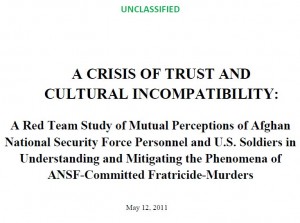DoD’s Bungled Answers to Questions on Re-Vetting ANSF and Cultural Awareness
On Saturday, I noted that the move by US Special Operations forces to halt training of Afghan Local Police and Afghan special forces while those entire forces were re-screened for security threats meant that there would need to be an equivalent action taken on the larger effort to train the Afghan National Army and Afghan National Police while they are re-screened:
So, while only Special Operations forces have suspended training for now, it is hard to see how this will not extend to all training of Afghan security forces soon, because the lapses in screening of recruits applies equally to the much larger ANA and ANP forces (approximately 350,000 for those two forces combined, compared to various estimates in the 20,000 range for the ALP and Afghan special forces when combined).
Even though it was a holiday weekend, it is remarkable that Pentagon Spokesman George Little was taken so off-guard in this line of questioning that Marcy pointed me to in Tuesday’s transcript:
Barbara, do you have a question?
Q: Thanks, two questions. On green-on-blue or insider attacks, what I didn’t hear you mention was that — what ISAF tells us is essentially all 350,000 Afghan security forces either have gone or are going through the process of being re-screened. And that comes from ISAF. So what would you — what does — what do you say to the families who have lost loved ones or their colleagues in the military after so many incidents this year alone? Who’s accountable for it taking so long for the U.S. military, for the coalition to realize they had to re-screen? Because for months, we were told isolated incidents, and apparently not.
MR. LITTLE: Well, let me put this in some perspective here, Barbara. It’s not that we have come only recently to this issue. We’ve taken it seriously for some time. In March of this year, six months ago, the — ISAF issued a tactical directive — and let me just list all that that tactical directive contained. It made it the adoption of specific and tailored force protection measures. Personnel and increased risks from insider attack were required to undertake specific close quarter combat and active shooter training. All commands are required to conduct refresher training, particularly for mentors and others who routinely work side-by-side with Afghans.
The directive required additional in-theater cultural awareness training. The directive also asked that coalition force units create safe zones inside ANSF compounds where they can defend themselves if necessary. And more recently, there’s been a great deal of focus by General Allen and his team on the importance of Guardian Angels, small unit leadership, and counterintelligence matters that will help identify potential attackers early on.
Q: But why did it take — and I have a follow-up to this, please — why did it take so long for the military in the department to come to the conclusion that 350,000 troops had to be re-screened? Why did (off mic)
MR. LITTLE: Three hundred and fifty thousand troops? Read more →

